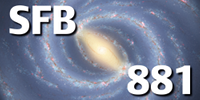Subproject P1: Quantifying the Impact of Feedback in the Milky Way Star-Forming Regions
Kathryn Kreckel (ARI)
The physical processes driving star formation are filtered through the interstellar medium (ISM), the gas and dust between stars that provides the raw materials of star formation. The ionized phase in particular, though it is not dominant by mass, simultaneously provides crucial insight into the physical conditions in the local ISM (metallicity, ionization parameter, density) and the ionizing source (young stars, supernovae, evolved stars). Systematic optical integral field spectroscopic (IFS) surveys of large (~1000 galaxy) samples are currently underway (CALIFA, Sanchez et al. 2012; MaNGA, Bundy et al. 2015; SAMI, Bryant et al. 2015). However, the tradeoff for these large samples is resolution, with typical physical scales of ~2 kpc, barely resolving key features like spiral arms and bars. Even with state-of-the-art surveys (e.g. PHANGS; Kreckel et al. 2018) that can for the first time spatially isolate individual ionized regions (HII regions, supernova remnants, diffuse ionized gas) across a wide area for a sample of galaxies, the targeted ~50 pc scales do not fully resolve the filamentary shock networks between regions or the ionization structure within individual regions. The Milky Way, where the necessary scales are accessible, is too extended on the sky to reasonably survey with existing instruments. The next step forward therefore comes only with the development of a new instrument and dedicated survey. The Sloan Digital Sky Survey (SDSS), with its proven legacy of producing rich, lasting, public data sets through ambitious sur- vey projects, has taken on this challenge. In their fifth incarnation (SDSS-V, Kollmeier et al. 2017), the Local Volume Mapper (LVM) will carry out full IFS coverage of a wide 1 sterradian area of the Milky Way at 1 pc resolution, along with galaxies in the Local Group (M31, M33, LMC, SMC) at less than 20pc resolution. LVM specstroscopy will cover the full optical wavelength range (3600-9800A) at high spatial and spectral (R~4000, 30 km/s) resolution suitable for physically isolating and tracing kinematic structures within HII regions and supernova remnants. This is the only project current- ly under development with the scope to address these crucial ~1pc scales across wide areas. With contigu- ous optical IFS observations across our own Milky Way, LVM will resolve the internal structure of star form- ing regions and ionized nebulae, enabling us to observe the “energy injection scale” and quantify the impact of feedback. SDSS-V is key to the science in this SFB, bridging the stellar spectroscopic expertise and the interstellar medium topics. Three of the institutes in Heidelberg participate in SDSS-V: MPIA, ARI and ITA. The main tasks for this subproject in the coming years will be (a) compiling catalogs of essential ancillary data from the archives and existing literature; (b) optimizing the survey strategy and target prioritization; (c) exploiting fully the LVM data as it becomes available. While SDSS-V operations will run from 2020-2025, LVM operations are realistically projected to begin in 2021 and will thus produce the first round of data within the time frame of this SFB project. By beginning now to compile the relevant ancillary resources and develop hands-on experience this postdoc will be optimally situated to take immediate advantage of the first data as it comes in. In addition, it is foreseen that they will lead to results that are publishable by themselves (e.g. results from tests on already existing data, optimized survey strategies, and added-value input catalogs).


